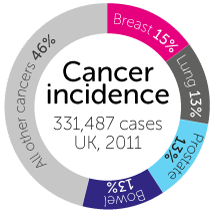As we said in previous blog entries, cancer is not a single disease, but a large group of diseases that can take place in any part of the body. We also have said that there are many risk factors that may play a major role in the outcome of these diseases. Therefore, depending on our lifestyle and our genetic information, we will have more or less chances of developing a cancer in our body.
In this figure we can see the top-20 common cancers in the United Kingdom in 2011 (similar information exists on other countries and regions). Not only we can see the incidence, but also divide it between both genders. Thanks to this fact, it is able to see that some of the most common cancers affect a different frequency between men and women. As it can be seen, the 4 most common types of cancer (by difference to the others) are breast (mainly for women), lung (both genders), prostate (for men) and bowel (both genders).
Nevertheless, before going into detail on these 4 cancers (in future blog entries), we will review how cancers are classified, which can be done in two different ways:
- Histologically: Depending on the type of tissue where cancer starts
- By site: Depending where the cancer first developed (primary site)
We will focus on the first classification, which is divided in two main categories:
- Solid tumours: This kind of tumours are defined by not having liquid areas or cysts, and are sub-classified depending on the types of cells that form them:
- Carcinoma: They represent the 80-90% of all cancers, and are related to the epithelial tissue of both the internal and external epithelium of the body. Thus, it comprises the skin, the gastrointestinal tract and the respiratory tract amongst others. We can see, then, why it comprises this high amount of cancers.
- Sarcoma: In contrast to the previous one, sarcomas are the cancers that have their origin in the supportive and connective tissue, comprising then bones, muscle, fat, tendons and cartilage. Interestingly, they are related to young ages, and are known to be painful.
- Haematological tumours:
- Leukaemia: Also known as cancer of blood cells, it emerges on the bone marrow (where these cells are produced). Due to its origin in blood cells, it is often associated to an increased production of white blood cells (cells in charge of the immune system response) not correctly finished, leading to a higher chance of having infections; and when it affects red blood cells (in charge of oxygen transport), errors in blood clotting and tiredness can appear. Interestingly, this is the most frequent type of cancer amongst children, although it affects more adults than children. (more information)
- Lymphoma: Also known as cancer of lymphatic cells, as it is developed in the nodes or glands of the lymphatic system (in charge of purifying body fluids and help with the immune response). It is important to clarify that there is some debate in order to decide if they are solid tumours or haematological ones. I prefer to call them haematological, but feel free to consider it in the other way. We could also add the myeloma together with lymphoma, as it is another kind of tumour also related to the lymphatic system (but originating in plasma cells). (more information)
Further information:


